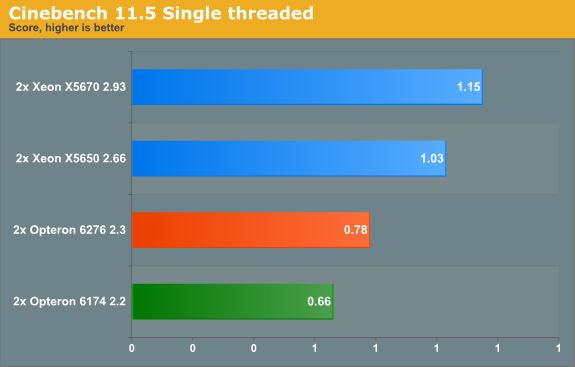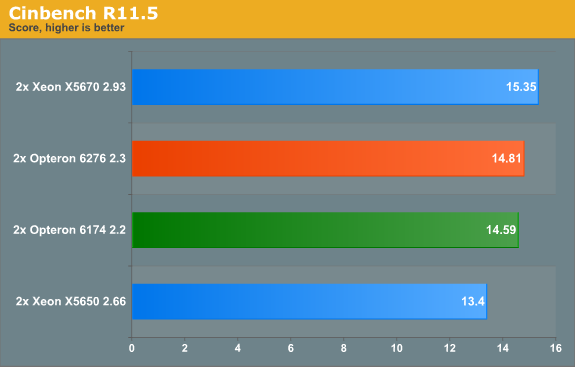Bulldozer for Servers: Testing AMD's "Interlagos" Opteron 6200 Series
by Johan De Gelas on November 15, 2011 5:09 PM ESTRendering Performance: Cinebench
Cinebench, based on MAXON's software CINEMA 4D, is probably one of the most popular benchmarks around, and it is pretty easy to perform this benchmark on your own home machine. The benchmark supports 64 threads, more than enough for our 24- and 32-thread test servers. First we tested single-threaded performance, to evaluate the performance of each core.

Single-threaded performance is relatively poor when you do not enable Turbo Core: with that setting the Opteron 6276 scores only 0.57. So the single-threaded FP performance is about 10% lower, probably a result of the higher FP/SSE latencies of the Interlagos FPU. However, the 6276 Opteron can boost the clock speed to 3.2GHz. This 39% clock speed boost leads to a 37% (!) performance boost. The difference with the older "Istanbul" based Opteron "Magny-cours" 61xx can only get larger once software with support for the powerful FMAC and AVX capable units is available. Also newer compilers will take the longer FP latencies into account and will probably boost performance by a few percent even without using FMAC or AVX.
Before we look at the Multi-threaded benchmark, Andreas Stiller, the legendary German C't Journalist ("Processor Whispers") sent me this comment:
"You should be aware that Cinebench 11.5 is using Intel openMP (libguide40.dll), which does not support AMD-NUMA"
So while Cinebench is a valid bench as quite a few people use the Intel OpenMP libraries, it is not representative of all render engines. In fact, Cinebench probably only represent the smaller part of the market that uses the Intel OpenMP API. On dual CPU systems, the Opteron machines run a bit slower than they should; on quad CPU systems, this lack of "AMD NUMA" awareness will have a larger impact.

We did not expect that the latest Opteron would outperform the previous one by a large margin. Cinebench is limited by SSE processing power. The ICC 11.0 compiler was the fastest compiler of its time for SSE/FP intensive software, even for the Opterons (up to 24% faster than the competing compilers), but it has no knowledge of newer architectures. And of course, the intel compiler does favor the Xeons.
The Opteron 6200 has a total of eight dual issue (if you count only those pipes that do calculations) FPUs, while the Opteron 6100 has a total of 12 dual issue FPUs. The only advantage that the 6200 has (if you do not use the FMAC or AVX capabilities) is that it can interleave two FP threads on one module. So you get 16 FP threads that can dispatch one FP per clock versus 12 FP threads that can dispatch two FP per clock. That capability is especially handy when your threads are blocked by memory accesses. This is hardly the case in Cinebench (but it is probably the reason why Interlagos does so well in some HPC tests) and as a result, the Opteron 6276 cannot pull away from the Opteron 6174.
Anand reported that the best Core i7 (2600K, 4 cores/8 threads, 3.4GHz) achieves 6.86. So considering that a dual Opteron 6200 is cheaper than the dual Xeon, and more manageable than two workstations, such a renderfarm may make some sense.










106 Comments
View All Comments
DigitalFreak - Tuesday, November 15, 2011 - link
Good to see that CPU-Z correctly reports the 6276 as 8 core, 16 thread, instead of falling for AMD's marketing BS.N4g4rok - Tuesday, November 15, 2011 - link
If each module possess two integer cores to a shared floating point core, what's to say that it can't be considered as a practical 16 core?phoenix_rizzen - Tuesday, November 15, 2011 - link
Each module includes 2x integer cores, correct. But the floating point core is "shared-separate", meaning it an be used as two separate 128-bit FPUs or as a single 256 FPU.Thus, each Bulldozer module can run either 3 or 4 threads simultaneously:
- 2x integer + 2x 128-bit FP threads, or
- 2x integer + 1x 256-bit FP threads
It's definitely a dual-core module. It's just that the number of threads it can run is flexible.
The thing to remember, though, is that these are separate hardware pipelines, not mickey-moused hyperthreaded pipelines.
JohanAnandtech - Tuesday, November 15, 2011 - link
You can get into a long discussion about that. The way that I see it, is that part of the core is "logical/virtual", the other part is real in Bulldozer . What is the difference between an SMT thread and CMT thread when they enter the fetch-decode stages? Nothing AFAIK, both instructions are interleaved, and they both have a "thread tag".The difference is when they are scheduled, the instructions enters a real core with only one context in the CMT Bulldozer. With SMT, the instructions enter a real core which still interleave two logical contexts. So the core still consists of two logical cores.
It is gets even more complicated when look at the FP "cores". AFAIK, the FP cores of Interlagos are nothing more than 8 SMT enabled cores.
alpha754293 - Tuesday, November 15, 2011 - link
I think that Johan is partially correct.The way I see it, the FPU on the Interlagos is this:
It's really a 256-bit wide FPU.
It can't really QUITE separate the ONE physical FPUs into two 128-bit wide FPUs, but it more probably in reality, interleaves them (which is really just code for "FPU-starved").
Intel's original HTT had this as a MAJOR problem, because the test back then can range from -30% to +30% performance increase. Floating-point intensive benchmarks have ALWAYS suffered mostly because suppose you're writing a calculator using ONLY 8-byte (64-bit) double precision.
NORMALLY, that should mean that you should be able to crunch through four DWORDs at the same time. And that's kinda/sorta true.
Now, if you are running two programs, really...I don't think that the CPU, the compiler (well..maybe), the OS, or the program knows that it needs to compile for 128-bit-wide FPUs if you're going to run two instances or two (different) calculators.
So it's resource starved in trying to do the calculation processes at the same time.
For non-FPU-heavy workloads, you can get away with that. For pretty much the entire scientific/math/engineering (SME) community; it's an 8-core processor or a highly crippled 16-core processor.
Intel's latest HTT seems to have addressed a lot of that, and in practical terms, you can see upwards of 30% performance advantage even with FPU-heavy workloads.
So in some cases, the definition of core depends on what you're going to be doing with it. For SME/HPC; it's good cuz it can do 12-actual-cores worth of work with 8 FPUs (33% more efficient), but sucks because unless they come out with a 32-thread/16-core monolithic die; as stated, it's only marginally better than the last. It's just cheaper. And going to get incrementally faster with higher clock speeds.
alpha754293 - Tuesday, November 15, 2011 - link
P.S. Also, like Anand's article about nVidia Optimus:Context switching even at the CPU level, while faster, is still costly. Perhaps maybe not nearly as costly as shuffling data around; but it's still pretty costly.
Samus - Wednesday, November 16, 2011 - link
Ouch, this is going to be AMD's Itanium. That is, it has architecture adoption problems that people simply won't build around. Maybe less substantial than IA64, but still a huge performance loss because of underutilized integer units.leexgx - Wednesday, November 16, 2011 - link
think they way CPU-z reporting it for BD cpus is correct each core has 2 FP, so 8 cores and 16 threads is correctto bad windows does not understand how to spread the load correctly on an amd cpu (windows 7 with HT cpus Intel works fine, spreads the load correctly, SP1 improves that more but for Intel cpus only)
windows 7 sp1 makes biger use of core parking and gives better cpu use on Intel cpus as i have been seeing on 3 systems most work loads now stay on the first 2 cores and the other 2 stay parked, on amd side its still broke with cool and quite enabled
Stuka87 - Tuesday, November 15, 2011 - link
So, what is your definition of a core?Bulldozers do not utilize hyper threading, which takes a single integer core and can at times put two threads into that single integer core. A Bulldozer core has actual hardware two run two threads at the same time. This would suggest there are two physical cores.
Does it perform like an intel 16 core (if there was such a thing), no. But that does not mean that it is not in fact a 16 core device. As the hardware is there. Yes they share an FPU, but that doesn't mean they are not cores.
Filiprino - Tuesday, November 15, 2011 - link
Actually, Bulldozer is 16 cores. It has two dedicated integer units and a float point unit which can act as two 128 bit units or one 256 bit unit for AVX. So, you can have 2 and 2 per module.Bulldozer does not use hyperthreading.